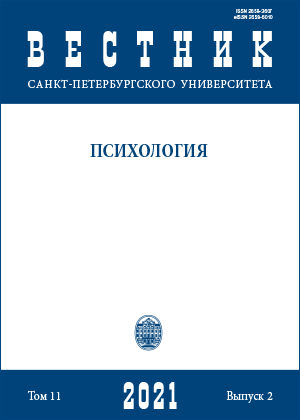Emotional Intelligence, Big Five Traits and Emotional Creativity in latent personality profiles
DOI:
https://doi.org/10.21638/spbu16.2021.201Abstract
Studies in the last decade that examined the relationship among the traits that form a personality profile, identified both the relationship between emotional intelligence and the Big Five traits or focused on arbitrarily identified mediators and moderators in the system of measured traits. However, our current understanding of the associations between Big Five traits and emotional creativity (a trait related to emotional intelligence) is lacking. Thus, the objective of the study was to identify latent profiles which represented homogenous subgroups of individuals based on measured personality traits; and to compare the results from a variablecentered approach and the person-centered approach (latent profile or class analysis). Design: a total of 527 students participated in the study (395 women and 135 men, Min 17, Max 43, M=19.2, SD=2.9), 402 were administered the complete assessment battery. The latter included 1) the Ten Item Personality Measure (TIPI), 2) the Trait Emotional Intelligent Questionnaire (TEIQ), 3) and the Emotional Creativity Inventory (ECI). The study shows that the traits of the Big Five as expected were positively associated with all the subscales of emotional intelligence. The analysis of latent profiles identified 4 distinct classes that do not appear when correlation analysis was used in a variable-centered analysis. Specifically, it was the properties of emotional intelligence that were the main group of discriminating variables when establishing personal profiles. Among the Big Five traits, Emotional Stability and, among the all emotional creativity components, Efficiency were the strongest discriminating factors; the maximum contribution to the identification of personal profiles was made by the traits of emotional intelligence.
Keywords:
latent profiles, emotional creativity, emotional intelligence, Trait Emotional Intelligent Questionnaire (TEIQ), Emotional Creativity Inventory (ECI)
Downloads
References
S. Mavroveli // Keefer K. V., Parker J. D. A., Saklofske D. X. (eds). Emotional Intelligence in Education. Cham, Switzerland: Springer, 2018. P. 49–81 (The Springer Series on Human Exceptionality). https://doi.org/10.1007/978-3-319-90633-1_3
References
Wright, R., Riedel, R., Sechrest, L., Lane, R.D., Smith, R. (2018). Sex differences in emotion recognition ability: The mediating role of trait emotional awareness. Motivation and emotion, 42 (1), pp. 149–160. https://doi.org/10.1007/s11031-017-9648-0
Downloads
Published
How to Cite
Issue
Section
License
Articles of "Vestnik of Saint Petersburg University. Psychology" are open access distributed under the terms of the License Agreement with Saint Petersburg State University, which permits to the authors unrestricted distribution and self-archiving free of charge.




